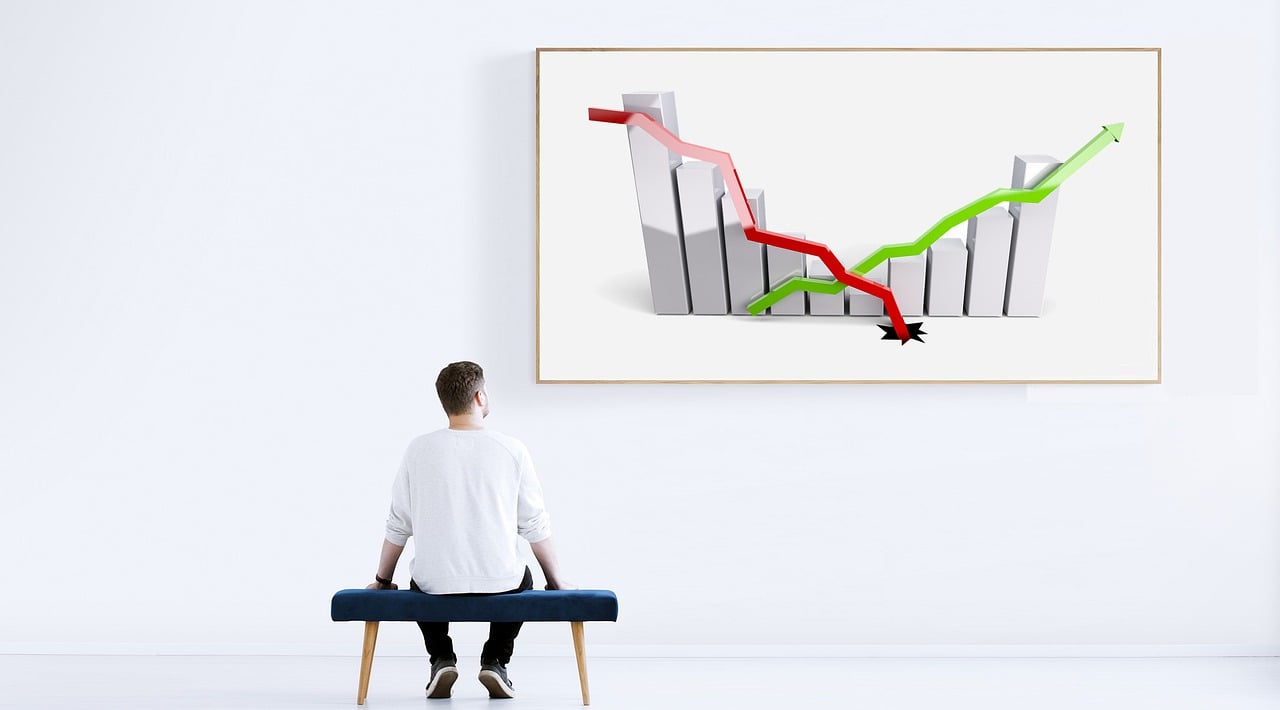Summary Analysis:
November was rough, although that would probably depend on your perspective. For investors who were 100% invested in equity and fixed income markets, this month was great with a 8-10% rally. Yet if you turn back the clock one month to October that same investor would have been taken for a wild roller coaster ride. For example, the S&P 500 reached a short term bottom of approximately 4,216 on October 3rd. Then eight days later the same index reached an interim high of 4,376 before retracing to a new bottom of 4,109 on October 27th. Unfortunately the whip saw wasn’t over as the S&P 500 rallied back to 4,358 seven days later.
Within 30 days (October 3rd to November 3rd) the level of volatility would make any investor sick.
That said, I feel like this is a Michael Burry moment. If you are not familiar with that name, he is the famous trader who shorted the housing market between 2006 – 2008. His story was turned into a movie called The Big Short.
The quick premise, Michael had completed an extensive amount of research into the residential real estate market in the years leading up to the Great Financial Crisis. His research led him to believe that rating agencies were misleading investors, banks were lending to unqualified homebuyers (sub-prime), there was a surplus of homes on the market, and investors were investing in collateralized mortgage backed securities (CMBS) based on inaccurate information. Michael was so convinced that the financial markets were propped up with toxic debt that he “bet against” the housing market for years. It was not until 2008 that his conviction resulted in a significant financial windfall for his investors.
To be clear, I am not saying the current stock market, or economic environment, is anything like 2008 – or that I am Michael Burry. In some cases the current economy could be worse, and in other cases it could be better. For example, today the largest banks are more well capitalized than they were in the 2008 crash. This was a byproduct of the “to big to fail” legislation passed in the wake of the 2008 crisis. However, the same cannot be said for the rest of the financial system. For example, those classified outside of the top 100 banks are currently showing signs of cracks. In Q3 2008 these “smaller” banks had charged off 7.1% of their credit card debt. This increased to a peak of 8.39% in Q4 2009. If we compare these numbers to Q3 2023, these same banks have reported a charge off of 8.50%… higher than the peak in Q4 2009. Now that may not be as much of an issue if debt today was similar or less than debt levels 15 years ago, but it is not.
According to the New York Federal Reserve consumer credit card debt was $860 billion in Q3 2008. Today consumer credit card debt is $1.08 trillion dollars.While this 25% increase may not appear to be a lot over 15 years, the low was $660 billion in Q1 2013. That means total credit card debt has increased 64% in approximately 10 years. With average credit card interest rates today at approximately 21% consumers are faced with the highest level of credit card debt since the Great Financial Crisis, which was accrued at an average of 6.4% per year, meaning consumers are paying more interest today than they did in 2008 – adjusted for inflation the increase would be approximately 4.4% annually (assuming a 2% inflation rate).
To compound concerns, mortgage and auto loan debt along with interest rates are at their highest level in approximately 15 years. In a consumer led economy this becomes a big issue for many reasons, none more apparent than the reduction in disposable cash flow. If consumers are paying more interest on the credit card debt, auto loan debt, and mortgage debt they have less money to spend on consumer goods, consumer services, and fundamental expenses.
Let me hammer this point home. We (society) have raised an entire generation in a “ZERO interest” environment. In other words, do you remember when the family saved up to go to the movies or to simply go out to a restaurant for dinner? I do. Parents were battling interest rates between 5% and 12%+ so there was less disposable income to “go around”. The recent generations have never experienced this choice, which makes for an uncomfortable environment for a group that hasn’t needed to prioritize expenses the same way older generations had too…
Let’s bring this home…
How did the economy get to where it is now? Simple. The Federal Reserve’s quantitative easing policy pumped money into the economy for 15 years. As money floated through the system corporate balance sheets were fortified, personal balance sheets ballooned, and government tax revenues grew. Now that the Fed has shifted to a tightening cycle money is being sucked out of the economy in the form of higher interest rates and letting bonds (related to quantitative easing) mature. If the Fed’s dual mandate is to fight inflation and seek “maximum employment” then the Fed can afford to sacrifice some level of employment to secure below average growth (0-2%) which will support below the target inflation rate of 2%. Furthermore, with less money floating in the system/economy the federal government will have less tax revenues to spend on maintaining their present/prior spending policies. Less revenues will either lead to more spending cuts or higher taxes for taxpayers, or a combination of both… neither promote economic growth. Sounds a lot like another lost decade of return… similar to 2000 – 2010.
Looking forward:
Based on my research, the Federal Reserve needs the unemployment rate to land between 5.25% and 6% (1.35% to 2.1% higher than where it stands today) in order to slow growth enough to introduce deflation into the economy – which will lead to economic contraction. As I will explain in the detail section below, a small amount of deflation is the only way to bring price stability to the US economy. Why? When 58% of those making $100,000 or less live paycheck to paycheckfuture economic growth becomes challenging. The alternative option would be for the economy to grow into the recent inflation spike, but with consumers stretched and small businesses struggling to finance growth with higher cost of capital it seems unlikely that the economy will grow into recent inflation spikes… hence, we need deflation.
When economic growth slows corporate profits decline year over year. When corporate profits decline stock valuations decline. Declines in stock valuations lead to declines in stock prices.
Therefore, based on my research, when consumer spending craters small business spending drops which rolls up and affects larger businesses. If small business represents approximately 44% of economic growth then the health of small businesses becomes a vital indicator of future growth.
Today, banks outside the top 100 (those classified to big to fail) are reporting credit card charge-offs not seen since 2010, small business sentiment is at a 22 month low (last seen before the 2022 market crash), and consumer credit topped $1.08 trillion (before the $38 billion spent during the Thanksgiving to Cyber Monday shopping season).
Headed into next year our portfolio strategy remains defensive.
Now, let’s move on to the detailed analysis!
Detailed Analysis:
To better explain the aforementioned summary I am going to provide you with some charts; however unlike previous charts in previous summaries the charts below focus on the comparison of the Russell Small Cap stock Index against a number of Sectors over the prior 10 years. Why am I including these charts? As you will see below, there is a very large divergence between the small cap market and the corresponding sectors. If nearly 40% of small cap stocks in the Russell 2000 are unprofitable – will higher borrowing costs drive economic growth or slow growth? This is the core question I will spend most of the detailed analysis attempting to answer, which will support my investment thesis for 2024.
Let me start off with some historical statistics before we dive deep.
- Average unemployment rate between 1990 – 2000 = 5.71%
- Average unemployment rate between 2000 – 2010 = 5.82%
- Average unemployment rate between 2010 – 2020 = 5%
- Average unemployment rate between 1990 – 2020 = 5.51%
- Small businesses accounted for 63% of new job growth between 1995 – 2021
- Small businesses employ approximately 46% of private sector jobs
- Small businesses account for 43.5% of GDP
- Negative 43% of business owners are expecting better business conditions
While past performance is no guarantee of future results, if consumer spending slows then small business revenues will decline. Revenue declines will lead to employee lay offs. With small businesses employing 46% of the private sector and the current unemployment rate for October being 3.9%, a significant amount of damage could be done to the US economy if the unemployment rate rises… especially amongst small businesses.
What conclusion am I left with?
The Federal Reserve cannot afford to let inflation return with vengeance. That means they are more likely to keep the short term Fed Funds Rate higher for longer. While the Federal Reserve may cut rates by the end of 2024 from a 5.25% – 5.5% range down to a 4.5% – 4.75% range, rates are still significantly higher than where they were two years ago. Higher rates lead to higher borrowing costs. Higher borrowing costs lead to higher prices on goods and serves; or higher costs could lead to level prices but increased unemployment to offset normalize costs. Increased unemployment leads to more consumer credit card delinquencies, defaults, lower spending, and a much higher probability of a recession.
Let’s turn to the charts to bring this investment thesis home.
- Russell Small Cap Index versus Market Cap Weighted S&P 500 – 2 Year
- Russell Small Cap Index versus Market Cap Weighted S&P 500 – 10 Year
- Russell Small Cap Index versus Equal Weighted S&P 500 – 10 Year
- Russell Small Cap Index versus Industrials Sector – 10 Year
- Russell Small Cap Index versus Materials Sector – 10 Year
- Russell Small Cap Index versus Semiconductor Sector – 10 Year
- Russell Small Cap Index versus Technology Sector – 10 Year
- Russell Small Cap Index versus Financials Sector – 10 Year
- Russell Small Cap Index versus Healthcare Sector – 10 Year
Unlike prior summaries I am not going to breakdown each chart in detail. Instead I am going to summarize some key points.
Russell 2000 versus Everything:
It is my belief that the Small Cap market is the canary in the coal mine. For over a year the Small Cap market has underperformed the broader market, along with many highly correlated sectors within the broad market.
If inflation is not expected to return to the 2% target, by the Federal Reserve’s own dot plot projection, until 2025 then US economic/GDP growth will have to come down significantly as higher interest rates slow the economy down. With so many sectors of the US economy currently dislocated from their prior correlations it is my assertion that these dislocations will end as markets drop.
10 Year Treasury:
Turning our attention to the 10 Year Treasury yield it is important to note rates have dropped from approximately 5% down to 4.33% today. That means the term premium increase (the premium paid for holding an investment for many years into the future) between September 1st (4.17%) and October 19th (4.98%) has almost completely evaporated (4.33% today).
To understand the importance of this rate volatility let me highlight a few key points:
- Historically speaking, rates are normally more stable. Bonds are supposed to be “boring”.
- The term premium increase in Q3 2023 led to bond losses because as rates increase bond prices decrease.
- The term premium increase was directly related to the massive Treasury issuance in Q3 and the reset in expectations for when the Federal Reserve would cut interest rates.
- Q4 2023 and Q1 2024 Treasury debt issuance is very similar in size to Q3 issuance.
- Rate cuts are projected to start as early as March 2024 and as late as July 2024.
What does this mean?
Today many Wall Street analysts are forecasting an average of four rate cuts, or a total of 1%, in 2024. This would be very aggressive making the probability of steep cuts much more challenging to accept. There are only two reasons I can see cuts like this happening:
- The Federal Reserve threads the needle perfectly and there is a “goldilocks” setup in the economy where growth slows, but not too much AND consumer spending continues at the same pace in prior years. OR;
- We have a steep recession leading the Federal Reserve to cut interest rates to spur growth. Unfortunately, they cannot cut rates too quickly if they are worried about inflation resurfacing quickly.
Should the 10 year Treasury move closer to 5.25%, or even toward 6% as term premium creeps back up, it is possible that 30 year mortgage rates could approach 9% – 9.5% as these two rates are indirectly linked. If this were to happen the entire bond market would continue to reprice and move downward. Only a significant flight to safety – which could happen with a steep recession – could put downward pressure on long term yields allowing long term yields to remain lower than estimates.
US Core Inflation Rate:
While core inflation continues to decline the rate continues to be stubbornly high. To reach the Federal Reserve’s 2% inflation target economic growth needs to sufficiently slow down. With Q3 2023 GDP revised upward to 5.2% from at 4.9% and Chair Powell’s comments about wanting below trend growth, core inflation needs to decline at a more rapid pace.
To accomplish lower inflation the Board of Governor’s needs to either continue increasing interest rates OR keep interest rates higher for longer than normal. However, in either case if the Federal Reserve delays rate cuts into a recession stock prices could decline steeper.
Content in this material is for general information only and not intended to provide specific advice or recommendations for any individual. You cannot invest directly in an index. Asset allocation is no guarantee of risk reduction. Past performance is no guarantee of future results.





